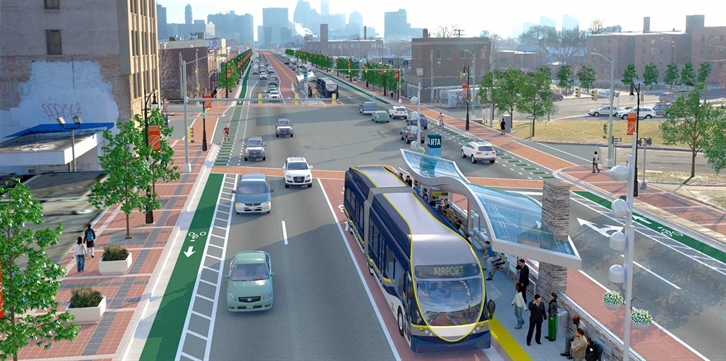If timing is key in politics, Wayne County Executive Warren Evans must be searching for his wristwatch right about now.
Last week, Evans awkwardly proposed a $5.4 billion, 20-year revised transit tax plan for southeast Michigan, based almost entirely on better bus services, at the same time that Detroit area car commuters endure a pothole season from hell.
The condition of highly traveled roadways in Wayne, Oakland, Macomb and Washtenaw counties is so bad that in some areas motorists are veering onto the grass, over the curb, detouring into business parking lots, or dangerously slamming on their brakes to avoid collisions with the roadway craters.
Tire blow-outs and broken wheels or suspensions – even fractured axles – have become routine. Each trip to the auto repair shop, riding shotgun with a behind-schedule tow truck driver, can cost several hundred dollars. Missing a day of work or being stuck in bumper-to-bumper traffic adds to the 2018 anxieties of Metro Detroit workers.
So, when Evans introduces a tax plan that will cost the average suburban Detroit homeowner more than $100 a year – with the majority of the money paid by those who never use the regional buses – the proposition serves as a prime example of government out of touch with constituents.
Due to many years of neglect, the number of crumbling Michigan roadways and bridges is spiraling out of control.
When Republican Gov. Rick Snyder signature legislation today adding another $175 million, a 7 percent increase, to Michigan’s road budget, he was roundly mocked by opposition Democratic lawmakers. When split up among counties, cities, townships and villages, that dollar amount will not be enough to pay for even one major road rebuilding project in any community in the state.
At the same time, the Evans mass transit plan was roundly criticized by Oakland County Executive L. Brooks Patterson – who called it “pie in the sky” — and Macomb County Executive Mark Hackel, both of whom said the focus has to be on road money, not buses.

An example of bus rapid transit that was previously under consideration.
As a selling point, the Wayne County executive offered a provision in his plan to provide funding for smooth bus rides on heavily traveled routes in the region. For the crater-filled Mound Road in Macomb County, his proposal offers $1.5 million toward pavement improvements. Yet, the county’s overall list of roads and bridges in poor condition exceeds $1 billion.
What’s more, the Evans plan takes a step back by abandoning the longtime vision by planners of Metro Detroit adopting the newest U.S. form of urban transportation – bus rapid transit, which essentially offers small commuter trains on wheels traveling on dedicated express lanes free of vehicle traffic.
Instead, the more modest plan amounts to little more than offering “premium” bus routes along five major corridors, expanded rush-hour service along 10 other routes, and so-called express service from all four counties to Detroit Metropolitan Airport in Romulus. There are a whole lot of gaps in service within that proposed bus grid.
According to Crain’s Detroit Business, the county executive’s proposal would ensure service every 15 minutes between 6 a.m. and 8 p.m. daily on Michigan, Grand River, Woodward, Mound/Van Dyke and Gratiot.
During peak rush hours, buses would stop every 15 minutes along 10 other routes, including Telegraph, Southfield, 12 Mile and Hall roads and Jefferson Avenue in Wayne County. That may accomplish little to help the transit needs of many workers in retail or food-service jobs.
Airport express routes would be created in all four counties. The plan also proposes building 15 new commuter lots for workers who do not live near a major bus stop.
All of this represents improvements to the Regional Transit Authority (RTA) tax plan that was narrowly defeated by Detroit area voters in November 2016, with the exception of abandoning wheeled-bus-trains on the region’s primary routes.
Still, at a time when billions of dollars are needed to replace the metro areas dilapidated roads and bridges, who can believe that voters will be convinced to instead pump billions of dollars into the region’s far-flung bus system?
Worse yet, the 1.5-mill proposal under consideration by the RTA for the November ballot could put in danger the long-held property tax funding source for the suburban bus system, the Suburban Mobility Authority for Regional Transportation (SMART).
The SMART tax – currently a 1-mill levy that reflects a tax hike approved by suburban voters a few years ago — comes up for a 4-year renewal on the August primary election ballot.
John Swatosh, the savvy former deputy general manager of SMART, said last week he worries that a 1-mill SMART tax renewal in August, followed by a 1.5-mill RTA increase in November, presents a bridge too far for voters who are fretting about basic infrastructure.
If frustrated voters/motorists rejected both plans, that would snap a string of successes by SMART in comfortably securing funds for the suburban bus system at the ballot box. The SMART team has done quite well by appealing to taxpayers to preserve buses that represent a “lifeline” for the poor, elderly and handicapped. The vast majority of suburbanites do not use the SMART bus system but they see the need for maintaining basic services for those in need.
“Don’t think a renewal is a slam dunk,” said Swatosh, a Hackel appointee on transit issues. “It is a risk every four years.”






